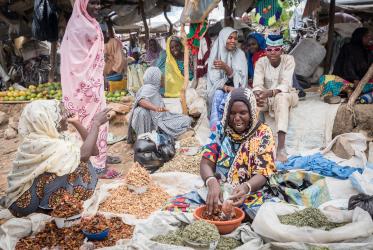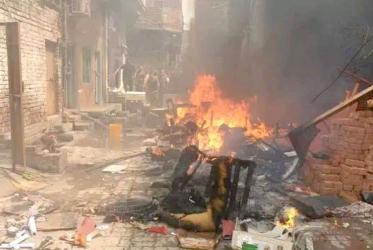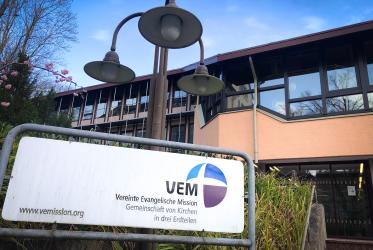Joint written statement* at the UN Commission on Human Rights' 62nd Session, Item
10: Economic, Social and Cultural Rights, 13 March-21 April, 2006
* Submitted by Franciscans International and the World Council of Churches, non-governmental
organizations in general consultative status, and Dominicans for Justice and Peace, Pax Christi
International and Pax Romana, international non-governmental organizations in special consultative
status.
Article 13 of the International Covenant on Economic, Social and Cultural Rights
1. The States Parties to the present Covenant recognize the right of everyone
to education. They agree that education shall be directed to the full development
of the human personality and the sense of its dignity, and shall
strengthen the respect for human rights and fundamental freedoms. They
further agree that education shall enable all persons to participate effectively
in a free society, promote understanding, tolerance and friendship
among all nations and all racial, ethnic or religious groups, and further the
activities of the United Nations for the maintenance of peace.
2. The development of a system of schools at all levels shall be actively pursued,
an adequate fellowship system shall be established and the material
conditions of teaching staff shall be continuously improved.
The Constitution of Pakistan framed in 1973 promised to its citizens in Article
37 (b) & (c) that "the State shall remove illiteracy and provide free and compulsory
secondary education within the minimum possible period; make technical
and professional education generally available and higher education equally accessible
to all on the basis of merit".
The Constitution also corresponds with Article 26 (1) of the Universal Declaration
of Human Rights which says that "Everyone has the right to education. Education
shall be free at least in the elementary and fundamental stages. Elementary education
shall be compulsory. Technical and professional education shall be made
generally available and higher education shall be equally accessible to all on the
basis of merit."
However education policies adopted by successive governments manifested the
least respect to the constitutional guarantees and international human rights standards
on education. A wide range of policy, budgetary and implementation issues
have held back progress at ground level and the country lags behind in literacy
and standards of education.
More than 50 million people aged above 10 years are still illiterate in the country
and the literacy rate is just over 54 percent, 66.25 percent for men and 41.75
percent for women; however unofficial estimates suggest that the functional literacy
is just over 35 percent. (HRCP, annual report 2004)
Public spending on education as a percentage of total government expenditure
has remained very low in Pakistan, 1.8 percent of GDP, well below prescribed
international levels that ranged between the 20 percent recommended by UNICEF
and the 6 percent laid down by the Dakar Framework of Action at the World
Educational Forum 2000. This spending is the lowest in South Asia. Pakistan
remains among the 12 countries of the world that spent less than 2 percent of
their GDP on education. (HRCP annual report 2005)
This indicates that education has remained a low priority. Public spending on
education in fact declined from 2.6 percent of the GDP in 1990 to 1.8 percent
in 2002-03.
Poor conditions at educational institutions
According to official statistics in 2004, there were 156,000 educational institutions
at the primary level in the public and private sector, 28,716 middle schools
and 16,059 high schools. This indicated an increase of 5.7, 12.7 and 8.6 percent
respectively over the past five years. (HRCP, annual report 2005)
The primary schools lacked physical infrastructure, furniture, basic facilities and
the level of teaching staff remained dismal. This has contributed greatly to the
high drop-out rate, which led to the lack of interest on parents' part in sending
children to schools where teachers often failed to appear, fans or drinking water
were not available and children were often beaten.
According to official data, 78 percent of primary schools in rural areas do not have
electricity, 40 percent have no drinking water and 60 percent are without toilets.
The same was true of middle, high and secondary schools. 15 percent of government
schools across the country are without buildings, 52 percent without boundary
walls, 40 percent without water, 71 percent without electricity and 57 percent
without toilets (HRCP annual report).
Higher education gained a significantly larger slice of the education budget in
recent years; however the declining standards of education, violence on the campuses
and limited resource availability for research continued to adversely affect
college and university students. At least two universities (Punjab and Bolan) and
the Federal Ministry of Education were headed by retired military officers.
Problems in the curriculum
Research in 2003 by Dr A.H. Nayyar and Mr Ahmed Salim of the SustainableDevelopment Policy Institute, Islamabad, identified the following problems inthe curriculum (Page 5, The state of curricula and textbooks in Pakistan): Inaccuracies of facts and omissions that serve substantially to distort thenature and significance of actual events in the history; Insensitivity to the existing religious diversity of the nation; Incitement to militancy and violence, including encouragement of Jihadand Shahadat (martyrdom); Perspectives that encourage prejudice, bigotry and discrimination towardsfellow citizens, especially women and religious minorities, and towardsother nations; A glorification of war and the use of force; Omission of concepts, events and material that could encourage critical selfawareness among students; Outdated and incoherent pedagogical practices that hinder the developmentof interest and insight among students.The present government made claims regarding changes in the curriculum toeliminate blatant discrimination based on gender and religion but in reality therewas no substantial change because:
a) Arabic, which is not spoken in any part of Pakistan, continues to be an
essential part of the syllabus.
b) Islamic Studies is a compulsory subject from class one to degree classes,
without an arrangement for non-Muslim students to obtain religious
instruction in their own faith.
c) In the admission for higher education the candidates claiming to have memorized
the Holy Quran are entitled to 20 extra marks.
d) The chapters on Islam are part of subjects of history, social studies and languages
which the non-Muslim students are obliged to study without a
choice.
Millennium Development Goals and the realities
The present government embarked on the Education Sector Reform Action Plan
to reform the education sector.
The government supported the organization, the National Commission for Human
Development (NCHD) which took over responsibility of education. The Education
for All targets included 86 percent literacy by 2015, and 100 percent enrolment
of children aged between five and seven years. A lavishly advertised mass literacy
campaign as part of Education Sector Reforms was launched by the Provincial
government of Punjab, and claimed the increase of enrolment, however there is
no evidence that the dropout rate has fallen with the Programme. The question
of quality education is yet to be ensured. The same is true for NCHD initiatives
in various districts of the country. Therefore Pakistan remains among 28 countries
at risk of failing to achieve these goals.
Recommendations
Education reforms change both the structure and content of the education syllabus,
decision-making and implementation. The reforms will require clear standards
to measure progress and independent oversight to keep the process on track
and deal with the problem that will inevitably arise from such an effort.
The following fundamental reforms are urgently required to ensure the right to
education for all people of Pakistan:
Priority needs to be given to education to catch up with the MDGs. As an
initial step, funding must be enhanced to at least the minimum of 20 percent
of GNP as recommended by UNESCO. Education needs to be acknowledged
by accepting that education is a responsibility of the state.
Spendings on non-productive sectors such as defence must be diverted to
the education sector.
School conditions including the state of buildings and the provision of basic
facilities need to be ensured given the terrible impact these have on children
seeking education.
The curricula and textbooks should be guided by the following principles:
Falsehood, distortions and omissions concerning the national history need to
be replaced by accounts of events that are supported by rigorous scholarship.
Encouraging or justifying discrimination against women, religious and ethnic
minorities, and against other nations, should be replaced with the positive
values of social equality, mutual respect and responsibility, justice and
peace.
Arbitrary concepts, incoherence, inconsistency and other pedagogical problems
should be replaced by a systematic set of scientific ideas about history,
geography, society and identity based on well- established academic disciplines.
Education will have to be saved from any preference for one religion in the
syllabus or in the form of incentives (extra marks on the basis of religious
learning) that are discriminatory in nature and practice.





